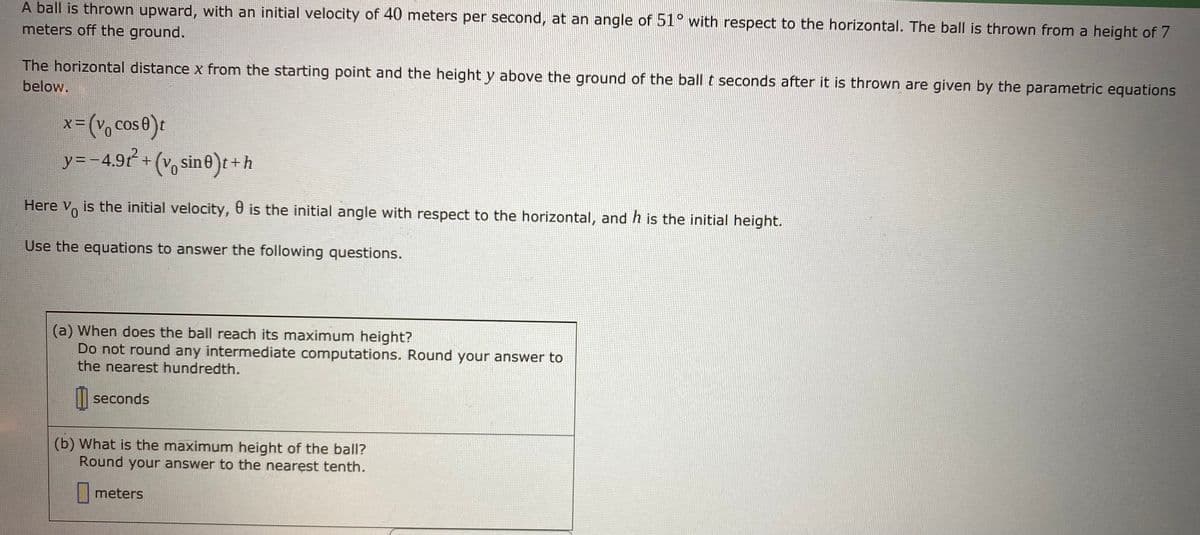The horizontal distance x from the starting point and the height y above the ground of the ball t seconds after it is thrown are given by the parametric equations below. x-(v, cose)t y=-4.9+ (% sine)t+h Here v is the initial velocity, 8 is the initial angle with respect to the horizontal, and h is the initial height. Use the equations to answer the following questions. (a) When does the ball reach its maximum height? Do not round any intermediate computations. Round your answer to the nearest hundredth. | seconds (b) What is the maximum height of the ball? Round your answer to the nearest tenth. meters
The horizontal distance x from the starting point and the height y above the ground of the ball t seconds after it is thrown are given by the parametric equations below. x-(v, cose)t y=-4.9+ (% sine)t+h Here v is the initial velocity, 8 is the initial angle with respect to the horizontal, and h is the initial height. Use the equations to answer the following questions. (a) When does the ball reach its maximum height? Do not round any intermediate computations. Round your answer to the nearest hundredth. | seconds (b) What is the maximum height of the ball? Round your answer to the nearest tenth. meters
Principles of Physics: A Calculus-Based Text
5th Edition
ISBN:9781133104261
Author:Raymond A. Serway, John W. Jewett
Publisher:Raymond A. Serway, John W. Jewett
Chapter3: Motion In Two Dimensions
Section: Chapter Questions
Problem 7OQ: A projectile is launched on the Earth with a certain initial velocity and moves without air...
Related questions
Question

Transcribed Image Text:A ball is thrown upward, with an initial velocity of 40 meters per second, at an angle of 51° with respect to the horizontal. The ball is thrown from a height of 7
meters off the ground.
The horizontal distance x from the starting point and the height y above the ground of the ball t seconds after it is thrown are given by the parametric equations
below.
x-(V, cose)t
y=-4.9 +(v, sine)t+h
(Vo
Here Vo is the initial velocity, 0 is the initial angle with respect to the horizontal, and h is the initial height.
0.
Use the equations to answer the following questions.
(a) When does the ball reach its maximum height?
Do not round any intermediate computations. Round your answer to
the nearest hundredth.
| seconds
(b) What is the maximum height of the ball?
Round your answer to the nearest tenth.
meters
Expert Solution
This question has been solved!
Explore an expertly crafted, step-by-step solution for a thorough understanding of key concepts.
This is a popular solution!
Trending now
This is a popular solution!
Step by step
Solved in 2 steps

Recommended textbooks for you

Principles of Physics: A Calculus-Based Text
Physics
ISBN:
9781133104261
Author:
Raymond A. Serway, John W. Jewett
Publisher:
Cengage Learning

Physics for Scientists and Engineers with Modern …
Physics
ISBN:
9781337553292
Author:
Raymond A. Serway, John W. Jewett
Publisher:
Cengage Learning

Physics for Scientists and Engineers
Physics
ISBN:
9781337553278
Author:
Raymond A. Serway, John W. Jewett
Publisher:
Cengage Learning

Principles of Physics: A Calculus-Based Text
Physics
ISBN:
9781133104261
Author:
Raymond A. Serway, John W. Jewett
Publisher:
Cengage Learning

Physics for Scientists and Engineers with Modern …
Physics
ISBN:
9781337553292
Author:
Raymond A. Serway, John W. Jewett
Publisher:
Cengage Learning

Physics for Scientists and Engineers
Physics
ISBN:
9781337553278
Author:
Raymond A. Serway, John W. Jewett
Publisher:
Cengage Learning

College Physics
Physics
ISBN:
9781285737027
Author:
Raymond A. Serway, Chris Vuille
Publisher:
Cengage Learning

Physics for Scientists and Engineers, Technology …
Physics
ISBN:
9781305116399
Author:
Raymond A. Serway, John W. Jewett
Publisher:
Cengage Learning